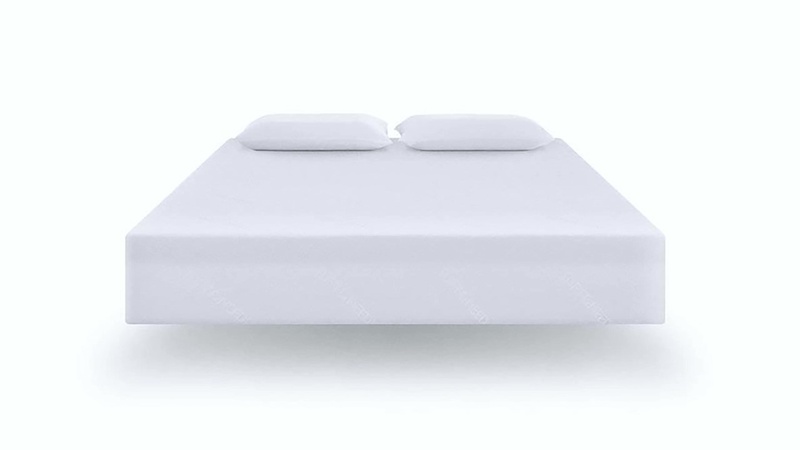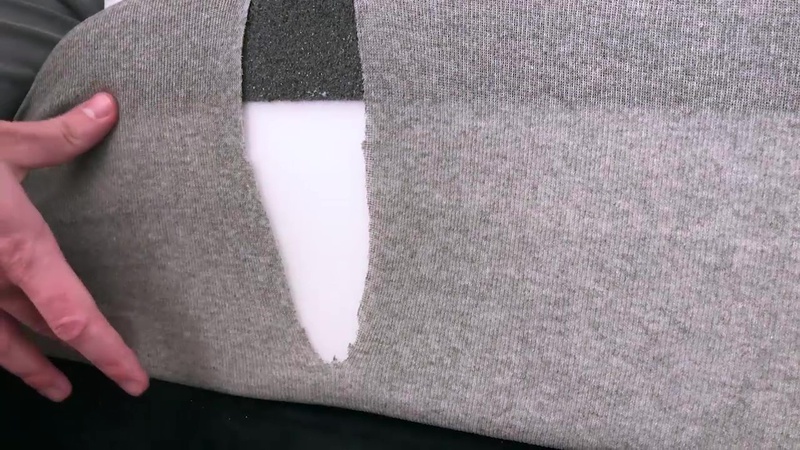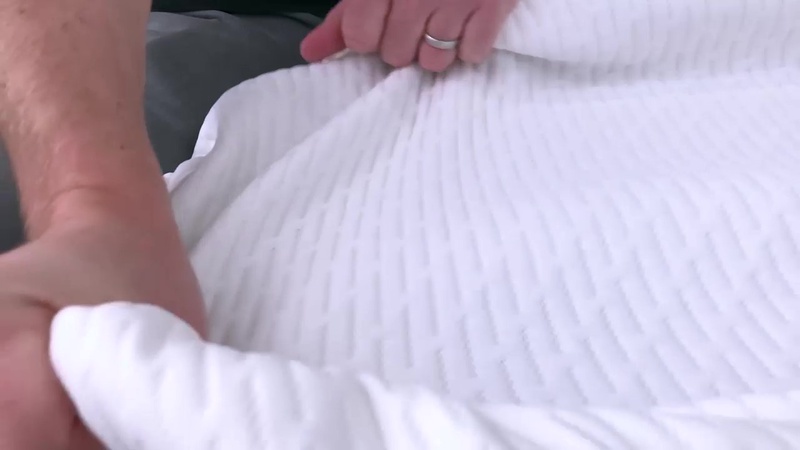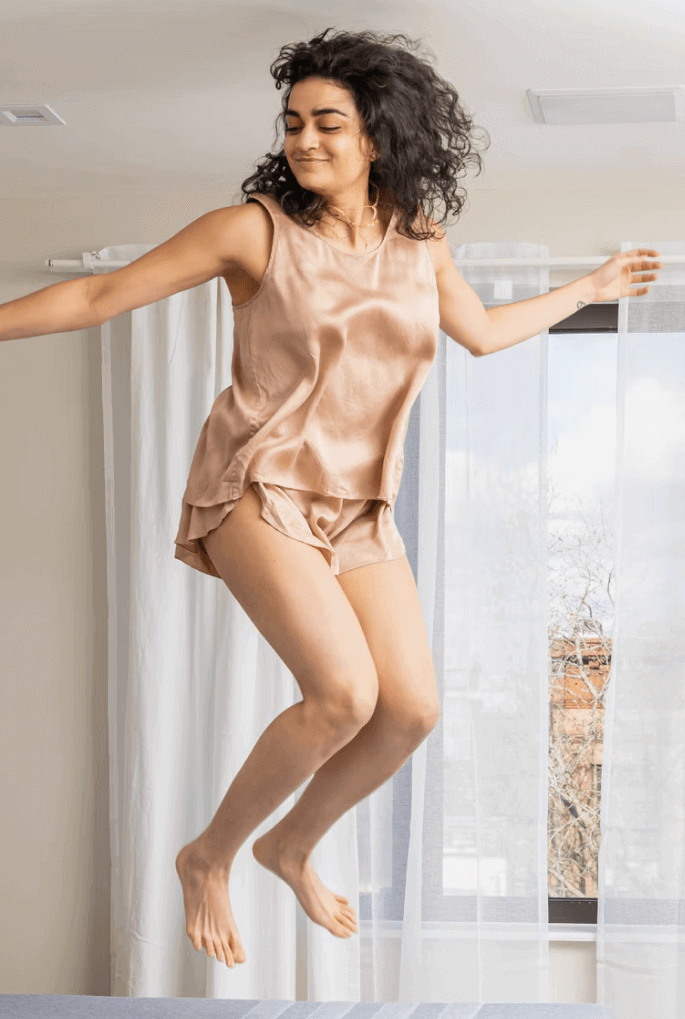Cover
The Tuft & Needle mattress is wrapped in thick and sturdy feeling cover.
Comfort & Feel
There are three aspects that make up our assessment of comfort and feel. We call these "preference-based characteristics" because no rating here is better or worse – rather, the attributes that are most desirable to you will be determined solely by your personal preferences. We apply the same classification standards to each mattress so you can more easily compare apples to apples.
Softness ( what’s this )
Keep in mind that what mattress companies call “firm” or “soft” is a purely a preference. All mattresses should be supportive and promote healthy spinal alignment. Whether a mattress is fluffy and squishy (what mattress companies call soft or plush), or less so (what companies call firm), is purely down to your personal needs and preferences.
We classify the Tuft & Needle mattress as a Medium Firm in terms of softness overall. Note that the current version of this bed is notable more firm than the 2017/2018 version, something to keep in mind if you tried a friend's Tuft & Needle bed, or viewed one in a showroom in the past.
Not sure what softness is best for you? Take our Mattress Match Quiz and find out.
| Softness Level (1=Least Soft, 9=Most Soft) |
4 | Medium Firm |
Cushioning Depth ( what’s this )
This refers to how deeply you sink into the mattress or feel cradled or hugged, versus a feeling of floating on top of the bed. We found the latest version of the Tuft & Needle bed to be about average, with a blend of feeling like you are floating on top vs sinking into the mattress. You can get a sense of this below with our 16-pound bowling ball.
| Cushioning Depth (1=Shallowest, 9=Deepest) |
5 | Average |

Memory Feel
Memory feel, which we also call responsiveness, refers to how quickly a mattress recovers its shape after being compressed. When you press your hand into the mattress, for instance, then remove it, does it take several seconds for the mattress to return to flat, or does it recover immediately?
The Tuft & Needle mattress does not have any of that recognizable memory-foam feel (as it contains no memory foam), where after compressed, your hand print takes several seconds to disappear (some describe this as a slow, melting into the mattress feeling).
Rather, the Tuft & Needle bed is very quick responding, meaning it recovers its shape almost immediately.
We also tested bounce in two ways. When we dropped our 16-lb. bowling ball in the mattress, it bounced a few times, but when our tester dropped his weight onto the bed, he did not bounce at all. This mattress has practically no bounce at all, which comes into play when we discuss motion isolation further below.
| Memory Feel (1=Least, 9=Most) |
1 | None |
Bounce
We also tested bounce in two ways. When we dropped our 16-lb. bowling ball in the mattress, it bounced a few times, but when our tester dropped his weight onto the bed, he did not bounce at all. This mattress has practically no bounce at all, which comes into play when we discuss motion isolation further below.
| Bounce (1=Least, 9=Most) |
3 | Not much bounce |
Back Support & Pressure Relief
The two things that you should always be sure to get from your mattress are spinal alignment (commonly thought of as "back support") and pressure relief. Unfortunately, no mattress will deliver these two things equally well for all sleepers. In particular, spinal alignment and pressure relief capabilities will vary across sleepers with different weights, body shapes, and sleep positions. To help you determine how this mattress will perform for you, we break down our spinal alignment and pressure relief assessments by sleeper type.
In our evaluations, the Tuft & Needle mattresses afforded very good support for back sleepers, and would be suitable for a broad range and sizes of people in that position.
The Tuft & Needle was also good in our view for stomach sleepers with the exception of those significantly heavier than our tester, where we questioned whether hips might sink into the mattress’s soft top layer too deeply, bottoming out on the firmer support layer.
We found the Tuft & Needle bed to be a questionable choice for side sleepers. For our tester, he found his shoulder not able to sink quite enough into the bed, which meant his spine was not as neutral as it could be. Those lighter than our tester would likely have an even harder time compressing the top foam in this position, and heavier people might sink right through the top foam to rest on the harder support foam.
Spinal Alignment
The key to good back support is maintaining proper spinal alignment while you sleep. This means that the mattress should hold your spine in roughly the same position it's in when you're standing. The ability of a given mattress to do this will generally depend on your weight, sleep position, and body shape.
Here is how we break down the spinal alignment of the Tuft & Needle mattress:
| Weight | Range | Back Sleepers | Side Sleepers | Stomach Sleepers |
| Lighter | <150 lb | 9 | 6 | 8 |
| Average | 150 to 200 lb | 9 | 7 | 8 |
| Above Average | 200 to 250 lb | 9 | 6 | 8 |
| Heavier | >250 lb | 9 | 5 | 7 |
Back Sleepers:
While our tester was on his back, he noted that his hips sank just deeply enough to create a perfectly neutral spine, while he felt the mattress did a nice job reaching up to support his lumbar curve. We feel that sleepers of a wide weight range would have a similar experience in this position on the Tuft & Needle mattress.
Side Sleepers:
Side sleeping was not ideal for our tester. While he didn’t experience any pain or pressure, his shoulders did not sink as deeply as he would have liked, resulting in some upward spinal curve. While the Tuft & Needle mattress may be just fine for those who only sleep occasionally on their sides, we especially question how supported heavier and also curvier people might be; the effect our tester experienced might be more exaggerated for those weighing more than about 200 pounds.
Stomach Sleepers:
Achieving good spinal alignment for stomach sleepers can often be trickier as the hips can tend to sink down too far with some mattresses, but our tester felt adequately supported in this position. We did question whether those significantly heavier -- over about 250 lbs. -- would experience the same support, and suspect that hips might sink far enough to create less than ideal spinal alignment.
Pressure Relief
When a mattress pushes back against your body with too much force in a concentrated area, the result can be pain, soreness, loss of circulation, excessive tossing, and other problems. In general, such "pressure points" are of greatest concern for side sleepers, since that's the position in which your body's weight is distributed over the smallest surface area. To find the right mattress for your needs, keep in mind that the pressure-relieving capabilities of any given mattress will vary depending on the sleeper. Factors like your weight and body shape (e.g., broader shoulders and/or hips) will determine how far you sink into the mattress, and the pressure relief offered by that mattress will vary widely at different depths.
Here's how we sized up the pressure relief of the Tuft & Needle mattress:
| Weight | Range | Typical Curves | Extra Curvy |
| Lighter | <150 lb | 6 | 6 |
| Average | 150 to 200 lb | 7 | 7 |
| Above Average | 200 to 250 lb | 7 | 6 |
| Heavier | >250 lb | 6 | 6 |
The experiences of our tester while side sleeping come into play with pressure relief too; his shoulders sunk through the soft top layer of foam, leaving his weight to rest on the firm support layer. For those that need good pressure relief, a softer mattress might be a better choice.
We also tried the mattress with the mattress topper accessory ($150 for a queen size) and found both side sleeping and pressure relief to be greatly improved.

Other Features
Beyond the preference-based characteristics of comfort and feel, and the body matching for spinal alignment and pressure relief, a mattress will have a number of other attributes that can make it a better or worse choice for you. We call these "priority-based characteristics" because they are areas in which a mattress can be better or worse, but that will have differing amounts of importance to each sleeper. So, determining how much importance to give to these features will be entirely a matter of your own personal priorities. As always, we apply the same ratings standards to each mattress so you can more easily compare apples to apples.
Motion Isolation (what’s this)
With a bowling pin standing upright on the Tuft & Needle bed, we tested motion isolation by dropping a 16-lb. bowling ball on it.
In the test, the pin barely moved, leading us to believe the bed would be an excellent choice for couples who don’t want to feel their partner getting in and out of bed.
| Motion Isolation Rating |
9 /10 | Excellent |
Temperature ( what’s this )
Beds made of all foam have a reputation for potentially sleeping hot since foam mattress invite less air flow than beds with innersprings. The Tuft & Needle mattress does have a couple of features intended to combat this. The top layer of foam is infused with flecks of gel and graphite. Both are conductors of heat, but in practical application, the effect would be subtle.
If overheating in bed is an issue for you, and you’ve experienced it with other mattresses, other models have features that are specifically intended to address this, but for most we don’t expect heat to be a problem with the Tuft & Needle bed.
| Stays 'Cool' Rating |
5 /10 | Okay |
Edge Support ( what’s this )
Foam mattresses aren’t typically very supportive along the very edge of the mattress—important if you like to sit on the edge of the bed, or if you tend to sleep along the edge. But the 2019 version of the Tuft & Needle has improved in this respect.
While our tester sunk into the mattress quite a bit while sitting and laying on the edge, he never felt unstable or like he was being ejected from the bed.
| Edge Support Rating |
7/10 | Good |
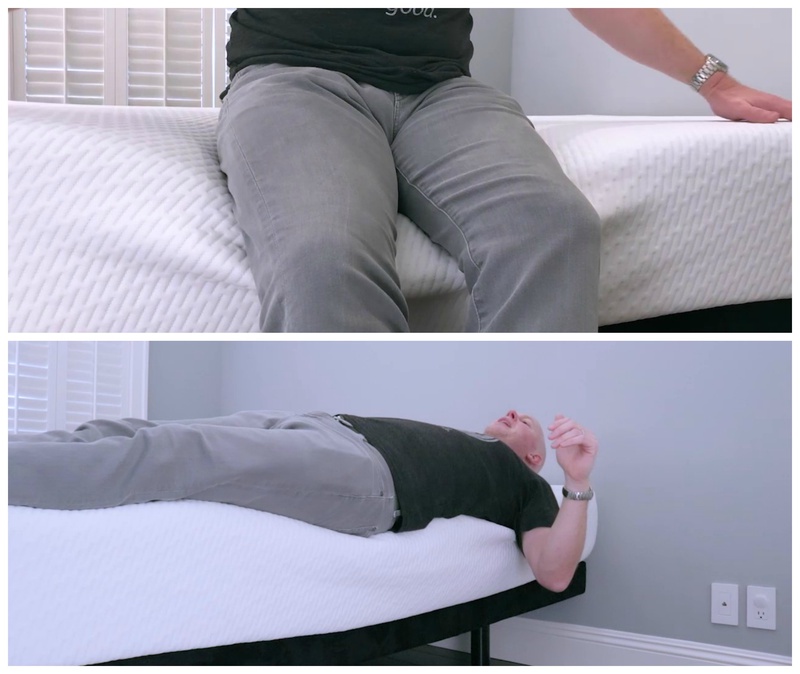
Ease of Repositioning ( what’s this )
If you tend to move and change positions a lot over the course of a night, ease of repositioning will be a priority for you. Our tester had no trouble changing positions and moving around on the Tuft & Needle mattress.
| Repositioning Rating |
9/10 | Excellent |
Green Features ( what’s this )
For mattress shoppers concerned with the use of natural materials, sustainable manufacturing practices or the like, we offer our subjective evaluation of any efforts taken by the company to make the mattress more green, healthy, or safe.
In the case of the Tuft & Needle mattress, the company makes no claims about the use of natural materials, however all of the foams used are certified to the CertiPUR-US standard, which verifies that a material has low VOC off-gassing as well as a lack of chemicals and other substances regulated by the CPSC. Furthermore, the entire mattress is certified to the OEKO-TEX 100 standard, an even more stringent certification that checks for a long list of allergens and harmful chemicals, and certifies minimal off-gassing.
| Green Rating |
4 /10 | Fair |
Adjustable Base Compatibility ( what’s this )
We tested the Tuft & Needle mattress on our standard adjustable base. The mattress won't be harmed if you use it on one. However, our brand new mattress did not conform very well to the base when we raised its head and foot. The mattress didn't settle onto the base at the foot, and when we got off the mattress, the middle popped right up. We would expect these conformance issues to improve as the mattress breaks in, but other mattresses conformed better right out of the box.
Overall, compatibility is "good" in the sense that your mattress won't be harmed by using it on an adjustable base, but it did not conform very well.
| Adjustable Base Use Rating |
7 /10 | Good |
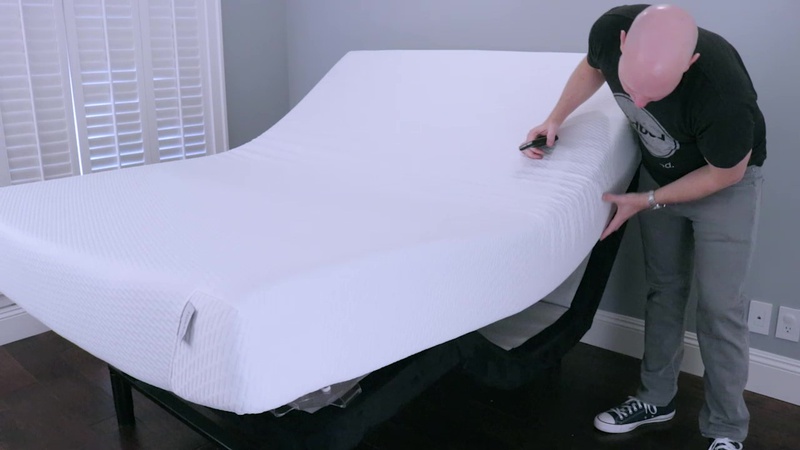
Price, Value & Longevity
How Much Does a Tuft & Needle Mattress Cost?
Prices shown are list prices. Remember that GoodBed keeps our site current with the best available discounts on all online mattresses, many of which are exclusive discounts for our readers.
What Are You Getting?
The Tuft & Needle mattress is a 10-inch mattress made of two layers of polyurethane foam glued together and wrapped in a sturdy cover, for a budget price. While the bed is sold mainly online, the company does have a handful of showrooms where you can check out the Tuft & Needle mattress before buying.
How Long Will the Tuft & Needle Mattress Last?
When it comes to estimating the comfort lifespan of a mattress, we tend to use foam density as our best, albeit imperfect, predictor of how long a foam will retain its shape and resiliency. For the Tuft & Needle mattress, the density of the top comfort layer of foam is 2.8 pounds. That's about half the density you would expect to find in higher end and more expensive foam and memory foam beds. The lower support layer is a 1.8-lb density foam, a standard density for a support foam. While the density of particularly the top layer of foam are lower than some of the competition, the Tuft & Needle warranty guarantees against significant sagging of deeper than 3/4", which matches the warranties much more expensive than this one.
Overall Value
The Tuft & Needle is a basic foam bed, and in our view, for many people, this may be all the mattress they need. On price, it compares very favorable to mattress-store beds, and even discount store mattresses (like IKEA). Compared to the online competition, it's also less expensive than most, and certainly right in line with other budget foam mattresses.If you prefer to try a mattress in a store, Tuft & Needle showrooms in Phoenix, Seattle, Kansas City, and Raleigh are a way to test in person but still take advantage of online pricing.
Taking all that together, from a performance standpoint, we’ve reviewed other beds that in our view were better for certain types of sleeping, had better pressure relief, had more plush covers, better edge support, etc. And some of those mattresses cost just a couple of hundred dollars more than the Tuft & Needle yet offer measurably better features. Even so, for a wide range of people of average size/weight, and especially for back sleepers, the Tuft & Needle bed is a low-hassle, basic mattress that comes with a top-notch 100-night trial period and solid 10-year warranty.
| Value Rating |
8 /10 | Very good |
Other Factors to Consider
Delivery
- Free delivery
Tuft & Needle includes free delivery, which is not particularly unusual among its competitors. Delivery is to your door. You are responsible for moving the mattress to your room and unpacking it. The queen size bed weighs about 72 pounds delivered, so it's likely a two-person job.
Returns
- 100-day trial period
- Full refund within trial period
Tuft & Needle offers buyers a 100-day trial period with a full refund if you decide the mattress isn't for you. The company does require proof that you have donated the mattress to a charity before processing a refund. That's often not as easy as it sounds, as many organizations do not accept mattress donations for hygiene reasons. The company does say it will help you find an organization that will take your mattress, however.
Warranty
- Warranty Length: 10 years
- Indentation Coverage: 3/4” and above
One of the biggest, if not THE biggest complaints about any mattress from consumers regards body impressions—the inability of a mattress to spring back, eventually creating a low spot/sinkhole in the mattress. As such, mattress warranties all contain a term defining how big a sag or ‘body impression’ (measured when no one is on the mattress) is considered a defect, and thus covered under the warranty. The industry standard for foam mattresses is 3/4" to 1”. Tuft & Needle has chosen to cover indentations that meet or exceed 3/4” for all of its mattresses, which should give you some extra peace of mind. Practically speaking, that means any softening or sagging would need to be at least that deep before the warranty would offer you protection. See: Tuft & Needle warranty










































 Related Video Reviews
Related Video Reviews

